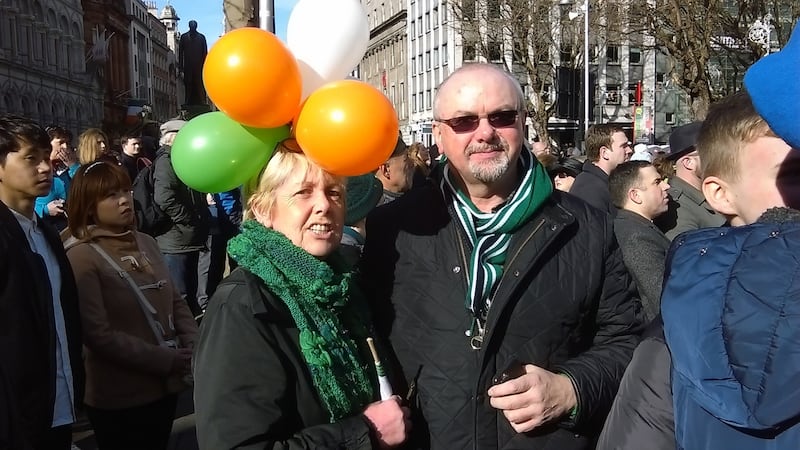Onlookers hung from walls and mounted bus shelters to catch the commemoration parade as it passed through Dublin city centre on Sunday, and most were utterly enthralled by the “inclusive” spectacle.
From early morning flags could be seen draped across barriers over much of the 4.5km route as spectators flocked from every part of Ireland and beyond, including early-comers the Haskins from Dún Laoghaire.
"There's a lot of effort has gone into it, it's very, very inclusive to all races and all nationalities. It's super," said John Haskins (54), standing beside his sister Angela who was sporting an ostentatious headdress of green, white and orange balloons.


Conspicuous among the crowds was a large contingent of tourists and visitors who were watching proceedings.
While some such as Sue and Terry Down from Dorset were simply "lucky" to catch the parade having heard about it on their cruise ship, the attendance of others came about as the result of months of meticulous preparation.
"We came over for the whole week to purposely coincide with this weekend," said Emmett O'Reilly (44), who is originally from Newry but now lives in Staffordshire with daughters Gráinne (8), Saoirse (5) and wife Julia.
“It’s nice to see a lot of non-Irish folk here as well, and obviously my children grew up out of Ireland so it’s important that they know who they are,” he added.
Despite all the impressive military machinery and armaments on display, Gráinne was in no doubt as to her favourite part of the parade as a group of bagpipers dressed in glengarry hats marched down Dame Street. “The bagpipes because my dad plays them,” she said.
For New Zealanders Jack Doherty (66) and Janine Carroll (62), who timed their ancestral fact-finding mission to Ireland to coincide with the centenary events, they believe their own 'adoptive' country can learn much from the patriotism of the occasion.
“They were never going to win this battle on Easter with the ship [AUD]sinking and their guns gone, so they were either totally foolhardy or had an incredible determination for freedom,” said Mr Doherty.
"We've been standing here reflecting on whether New Zealand could do this yet, and the answer is no. We've got a lot of work to do before we can have a parade of all the people that make up New Zealand and feel this positive about it," he added.
Some were less enthused about what they saw, but for widely varying reasons.
"When the Rising was finished, there was still the six counties that haven't been sorted out… The men that died in 1916 fought for something bigger," said one spectator from Lurgan, Co Armagh who wished to remain unnamed.
Although happy that her parents were comfortably camped on collapsible chairs opposite the Bank of Ireland on College Green, Diane Sims (52) was unimpressed with the view.
“It’s a bit sad we can’t actually see what’s going past, it seems to be all blackout barriers and there was nowhere else to go so we had to watch it on the screen,” she said.
Still, her 82 year-old mother Audrey Daly was delighted with her decision to come up from Kilkenny for the day.
“I’m very proud of everything that went on there. They had their own beliefs, they fought for Ireland and I’m very proud of that. I think they should have done that. If I was alive then I would have been in the Cumann na mBán I know that, definitely,” said Ms Daly, who learned much of what she knows about the Rising through her parents who were teenagers at the time.








